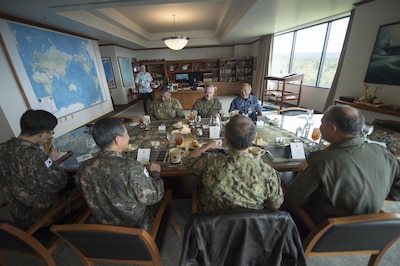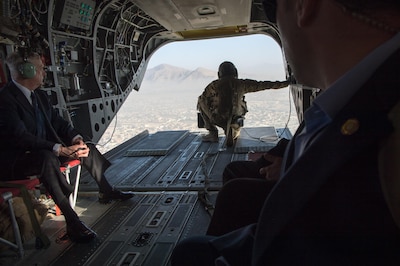By Jim Garamone DoD News, Defense Media Activity
WASHINGTON, Oct. 31, 2017 — The world is united against
North Korea’s nuclear and missile threats and nations are working together to
counter the dangers of Kim Jong Un’s ambitions, the chairman of the Joint Chiefs
of Staff said Oct. 29 following the trilateral military meeting with South
Korean and Japanese leaders.
Marine Corps Gen. Joe Dunford hosted his counterparts --
South Korean Air Force Gen. Jeong Kyeong-doo, chairman of the South Korean
Joint Chiefs of Staff, and Japan Maritime Self-Defense Force Adm. Katsutoshi
Kawano, Japan Self-Defense Force chief of staff -- in trilateral talks at U.S.
Pacific Command headquarters in Hawaii that focused narrowly on the threat
posed by North Korea.
The chairman said the first thing the three military leaders
did was establish a baseline of the threat. “One of the first discussions we
had was on how we see [North Korea],” Dunford said to reporters traveling with
him. “We have a common understanding of the challenge. As military leaders we
have a common understanding about the coherent, collective response to that
challenge. What we try to do is find ways to enhance our collective abilities.”
Trilateral, Multilateral Cooperation
To combat North Korea’s nuclear and missile threats, the
military leaders agreed the nations need to work together both on a trilateral
basis and in multilateral efforts. “That includes missile defense and any
planning and focus on the nuclear threat posed by North Korea,” Dunford said.
South Korean leaders agreed, saying that trilateral
cooperation is a proper response for missile defense and the nuclear threat.
For ballistic missile defense, time is of the essence. Good communications
among the nations is crucial to safeguarding the people of the region and the
United States.
This was the fifth trilateral meeting since 2014, and
cooperation has been easier each time, defense officials said. “Essentially, in
the next year the chiefs of defense agreed to improve ballistic missile
defenses, all wrapped up with better sharing of data, and to conduct routine
exercises to ensure we have a coherent collective response to ballistic missile
defense,” Dunford said.
The three leaders agreed to meet twice in the coming year.
“We had discussions two years ago about ballistic missile
defense and information sharing and since then we have done a number of
exercises and improved trilateral ballistic missile defense capability over the
past two years,” Dunford said. “We talked about information sharing and we
actually now have links to be able to provide information across the three
countries in a much more effective way.”
Kim Jong Un tested intercontinental ballistic missiles in
July -- alleging that the missiles can reach “anywhere in the world” -- and
detonated a nuclear device Sept. 3. Two intermediate range missiles overflew
Japan on Aug. 29 and Sept. 15. Kim has threatened to launch and detonate a
hydrogen bomb over the Pacific, and world leaders must treat that threat as
credible, defense officials have said.
Successful ballistic missile defense needs to have the
United States, South Korea and Japan sharing information and intelligence
quickly, and the three leaders promised to do so.
Japan Critical to Response
“If we do have to respond [to North Korea] militarily, Japan
is a critical platform from which the United States is going to meet its
alliance commitments to [South] Korea,” Dunford said. “We have more than 50,000
forces in Japan. It is a platform from which we project power in a South Korean
response. So the military relationship between South Korea and Japan is very
important.”
But multilateralism has additional uses, the chairman said,
including maritime interdiction operations, humanitarian assistance and
disaster response exercises and anti-submarine warfare. Nations in the region
are concerned about the North Korean threat and will work with South Korea,
Japan, the United States and others to enforce United Nations Security Council
resolutions and the sanctions they impose on the Kim regime, Dunford said.
During the trilateral meeting, the military leaders
discussed where already-planned U.S. Pacific Command exercises can be leveraged
to improve multilateral capability in the region.
Pacom is part of a broader, regional meeting of chiefs of
defense, where leaders discuss the full range of defense issues in the
Indo-Asia-Pacific region.
“It is important that Japanese and South Korean military
leaders are talking. From a deterrence perspective it is important that Kim
Jong Un and [North Korea] see that they are facing a collective response from
the international community, in particular those nations most affected,”
Dunford said.
The chairman said the military-to-military relationship
between Korean and Japanese forces is professional, but acknowledged that there
are challenges that must be worked out.
Defeating the threat is tough, he said. The preferred
solution is that Kim Jong Un realize the error of his ways and he steps away
from nuclear and missile technology, Dunford said, adding that United Nations
sanctions need time to bite, and perhaps that will convince the North Korean
leader.
But ensuring defense also takes time, the chairman said.
“You have to ensure that the path of capability development is on the ascent,”
he said.
“From year to year, it is hard to measure incremental
increases in capability development, but now I am able to look back over the
two years that we’ve been meeting and I feel pretty good about it,” Dunford
said. “We’ve put in place material changes to our ability to respond.”









